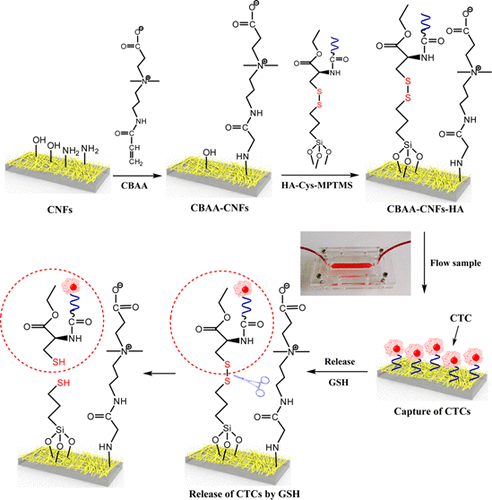当前位置:
X-MOL 学术
›
Bioconjugate Chem.
›
论文详情
Our official English website, www.x-mol.net, welcomes your feedback! (Note: you will need to create a separate account there.)
A Microfluidic Chip Integrated with Hyaluronic Acid-Functionalized Electrospun Chitosan Nanofibers for Specific Capture and Nondestructive Release of CD44-Overexpressing Circulating Tumor Cells
Bioconjugate Chemistry ( IF 4.7 ) Pub Date : 2018-02-07 00:00:00 , DOI: 10.1021/acs.bioconjchem.7b00747 Mengyuan Wang , Yunchao Xiao , Lizhou Lin 1 , Xiaoyue Zhu , Lianfang Du 1 , Xiangyang Shi
Bioconjugate Chemistry ( IF 4.7 ) Pub Date : 2018-02-07 00:00:00 , DOI: 10.1021/acs.bioconjchem.7b00747 Mengyuan Wang , Yunchao Xiao , Lizhou Lin 1 , Xiaoyue Zhu , Lianfang Du 1 , Xiangyang Shi
Affiliation

|
Detection of circulating tumor cells (CTCs) in peripheral blood is of paramount significance for early-stage cancer diagnosis, estimation of cancer development, and individualized cancer therapy. Herein, we report the development of hyaluronic acid (HA)-functionalized electrospun chitosan nanofiber (CNF)-integrated microfludic platform for highly specific capture and nondestructive release of CTCs. First, electrospun CNFs were formed and modified with zwitterion of carboxyl betaine acrylamide (CBAA) via Michael addition reaction and then targeting ligand HA through a disulfide bond. We show that the formed nanofibers still maintain the smooth fibrous morphology after sequential surface modifications, have a good hemocompatibility, and exhibit an excellent antifouling property due to the CBAA modification. After being embedded within a microfluidic chip, the fibrous mat can capture cancer cells (A549, a human lung cancer cell line) with an efficiency of 91% at a flow rate of 1.0 mL/h. Additionally, intact release of cancer cells is able to be achieved after treatment with glutathione for 40 min to have a release efficiency of 90%. Clinical applications show that 9 of 10 nonsmall-cell lung cancer patients and 5 of 5 breast cancer patients are diagnosed to have CTCs (1 to 18 CTCs per mL of blood). Our results suggest that the developed microfluidic system integrated with functionalized CNF mats may be employed for effective CTCs capture for clinical diagnosis of cancer.
中文翻译:

微流控芯片与透明质酸功能化的静电纺丝壳聚糖纳米纤维集成的特异性捕获和CD44过表达的循环肿瘤细胞的非破坏性释放。
外周血中循环肿瘤细胞(CTC)的检测对于早期癌症诊断,癌症发展评估和个体化癌症治疗至关重要。在本文中,我们报告了玻尿酸(HA)功能化的静电纺丝壳聚糖纳米纤维(CNF)集成的微流控平台的发展,以实现CTC的高特异性捕获和无损释放。首先,形成电纺CNF,并通过迈克尔加成反应用羧基甜菜碱丙烯酰胺(CBAA)的两性离子修饰,然后通过二硫键靶向配体HA。我们表明,形成的纳米纤维在连续的表面修饰后仍保持光滑的纤维形态,具有良好的血液相容性,并且由于CBAA修饰而表现出优异的防污性能。嵌入到微流控芯片中后,纤维垫可以以1.0 mL / h的流速以91%的效率捕获癌细胞(A549,人肺癌细胞系)。另外,在用谷胱甘肽处理40分钟后能够实现癌细胞的完整释放,从而具有90%的释放效率。临床应用表明,每10名非小细胞肺癌患者中有9名和5名乳腺癌患者中有5名被诊断出具有CTC(每毫升血液1至18个CTC)。我们的结果表明,与功能化CNF垫集成的已开发的微流体系统可用于有效CTC捕获,以用于癌症的临床诊断。谷胱甘肽处理40分钟后,可以实现癌细胞的完整释放,释放效率达到90%。临床应用表明,每10名非小细胞肺癌患者中有9名和5名乳腺癌患者中有5名被诊断出具有CTC(每毫升血液1至18个CTC)。我们的结果表明,与功能化CNF垫集成的已开发的微流体系统可用于有效CTC捕获,以用于癌症的临床诊断。谷胱甘肽处理40分钟后,可以实现癌细胞的完整释放,释放效率达到90%。临床应用表明,每10名非小细胞肺癌患者中有9名和5名乳腺癌患者中有5名被诊断出具有CTC(每毫升血液1至18个CTC)。我们的结果表明,与功能化CNF垫集成的已开发的微流体系统可用于有效CTC捕获,以用于癌症的临床诊断。
更新日期:2018-02-07
中文翻译:

微流控芯片与透明质酸功能化的静电纺丝壳聚糖纳米纤维集成的特异性捕获和CD44过表达的循环肿瘤细胞的非破坏性释放。
外周血中循环肿瘤细胞(CTC)的检测对于早期癌症诊断,癌症发展评估和个体化癌症治疗至关重要。在本文中,我们报告了玻尿酸(HA)功能化的静电纺丝壳聚糖纳米纤维(CNF)集成的微流控平台的发展,以实现CTC的高特异性捕获和无损释放。首先,形成电纺CNF,并通过迈克尔加成反应用羧基甜菜碱丙烯酰胺(CBAA)的两性离子修饰,然后通过二硫键靶向配体HA。我们表明,形成的纳米纤维在连续的表面修饰后仍保持光滑的纤维形态,具有良好的血液相容性,并且由于CBAA修饰而表现出优异的防污性能。嵌入到微流控芯片中后,纤维垫可以以1.0 mL / h的流速以91%的效率捕获癌细胞(A549,人肺癌细胞系)。另外,在用谷胱甘肽处理40分钟后能够实现癌细胞的完整释放,从而具有90%的释放效率。临床应用表明,每10名非小细胞肺癌患者中有9名和5名乳腺癌患者中有5名被诊断出具有CTC(每毫升血液1至18个CTC)。我们的结果表明,与功能化CNF垫集成的已开发的微流体系统可用于有效CTC捕获,以用于癌症的临床诊断。谷胱甘肽处理40分钟后,可以实现癌细胞的完整释放,释放效率达到90%。临床应用表明,每10名非小细胞肺癌患者中有9名和5名乳腺癌患者中有5名被诊断出具有CTC(每毫升血液1至18个CTC)。我们的结果表明,与功能化CNF垫集成的已开发的微流体系统可用于有效CTC捕获,以用于癌症的临床诊断。谷胱甘肽处理40分钟后,可以实现癌细胞的完整释放,释放效率达到90%。临床应用表明,每10名非小细胞肺癌患者中有9名和5名乳腺癌患者中有5名被诊断出具有CTC(每毫升血液1至18个CTC)。我们的结果表明,与功能化CNF垫集成的已开发的微流体系统可用于有效CTC捕获,以用于癌症的临床诊断。



























 京公网安备 11010802027423号
京公网安备 11010802027423号